Term archive

投稿タイプ:events
TWINKLE JOYO Starlight Pageant
The natural winter scenes and objects illuminated in this event add poetic charm to the season in Joyo City. 600,000 illuminating lights and a 10m tall tree show off the city's wonder.
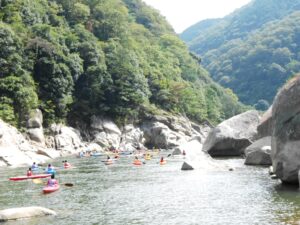
投稿タイプ:events
Kasagi Canoe School
With 70 canoes, Kasagi Canoe School is Japan's largest.
The school is mainly aimed at beginners, and uses the gentle flow of the center of the Kizugawa River as a slope with which to teach first-timers the basics, after which participants can head down 6km of the river themselves.
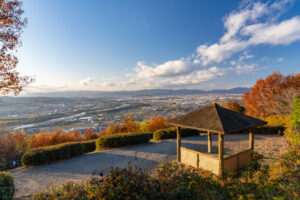
投稿タイプ:sightseeing
Mandoro-yama Viewpoint
Yamashiro Basin developed around Kizu River and flourished as a farming community. It supported and connected the two ancient capitals, Kyoto and Nara. Mandoro-yama Viewpoint, located in Ide Town, offers a stunning view of this area grown with its rich history. You can enjoy a panoramic view extending from Kyoto City, with its iconic Nidec Kyoto Tower, all the way to Osaka, home to Hirakata Park. The beautiful scenery includes Yamashiro-ohashi Bridge, Keihanna Science City, Mt. Ikoma and other mountains.
It’s not only amazing during the day, but also wonderful during twilight hours and at night.
It’s interesting that the name “Mandoro (numerous lanterns)” comes from a procession of torches that looked like many lanterns during a rainmaking ritual.
In this area, there is Teoterasu Ide where you can savor local food and find gifts,
Tama River where you can view cherry blossoms in spring and fireflies in early summer, and more. You can also enjoy seasonal fruit picking and visit historic remains.
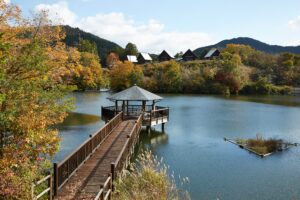
投稿タイプ:sightseeing
Taisho Pond Green Park
You can enjoy outdoor activities at Taisho Pond Green Park. It has bungalows, a camping site where you can pitch your tent anywhere in a designated area or on one of their tent decks, and an auto-camping site where you can easily drive your car directly to your parking space. There is also a barbeque area for those who prefer to enjoy a day trip. In the main house, there is a multipurpose room that is especially suitable for large group accommodations or seminars.
Taisho Pond is surrounded by lush greenery, offering a peaceful retreat with walking paths and a floating pavilion. It is registered as one of the Scenic Assets of Kyoto Prefecture. Just strolling in the park is fun. You can even find a bridge that is said to grant only one wish.
For those who are looking for more adventure, stop by the nearby Mandoro-yama Viewpoint on your way back. You can see Kizu River, Mt. Ikoma and other mountains, Keihanna Science City, Kyoto City, and so on.
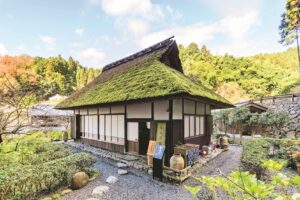
投稿タイプ:sightseeing
Birthplace of Nagatani Souen
This is the birthplace of Nagatani Souen, rebuilt in 1960. He developed and popularized the Aosei Sencha Seihou method in 1738, which laid the foundation for the processing method of some of today’s Japanese green teas including sencha (one of the most common Japanese teas). Inside the thatched house, you can still see the spot where Souen actually used a hoiro (a heater to dry things such as tea leaves and food in processing) to make tea. There is also a video that explains the tea processing method and Souen's history. The original house was a large-scale structure, which had not only the main house, but also a tea-making shed and a barn. The grounds extended to the place next to the adjacent Chasomyo Shrine. The place still bears the marks of its age with the stone wall remnants.
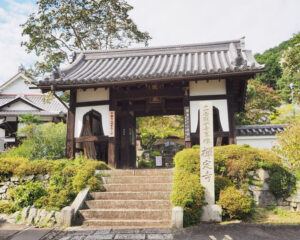
投稿タイプ:sightseeing
Zenjoji Temple
Zenjoji Temple was founded over a millennium ago. It was founded by Heiso, a monk from Todaiji Temple, a renowned temple in Nara.
The temple has a precious collection of Important Cultural Properties, including Juuichimen Kannon Bosatsu (Eleven-headed Kannon Bodhisattva) that is the temple’s principal image, Nikko Bosatsu (Bodhisattva of Sunlight) and Gakko Bosatsu (Bodhisattva of Moonlight). The documents concerning the temple itself have also been preserved, which hold historical significance.
You can also see a large Nehan-zu (depicting the passing away of the Buddha Shakyamuni), painted to commemorate the temple's 1,000th anniversary.
The main hall, established in 1680, is characterized by its large reeded roof. It has a rich history, and is a rare treasure due to its unique roof support structure.
In the autumn and winter, you can see the sight of Kakiya (drying rack for persimmons). Persimmons are a popular autumn fruit in Japan. A dried persimmon called Korogaki is one of the local specialties of Ujitawara Town. The scenery of Kakiya can only be seen in Ujitawara.
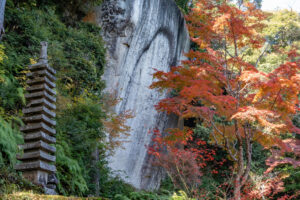
投稿タイプ:sightseeing
Kasagidera Temple
The origins of Kasagidera Temple are astonishingly ancient. Already 2000 years ago, the giant boulders of Mount Kasagi were objects of worship. Over its long history, this place has been known as a training ground for mountain worship, too.
Today, the temple is famous especially for its enormous Magaibutsu (Buddhist figures carved into boulders). The temple’s principal object of worship is Maitreya (Miroku Bosatsu). There is a fascinating story behind it.
When Emperor Tenmu was still known as Prince Oama, he went hunting deer. While chasing a deer, he almost fell off a steep cliff with his horse. He prayed to the mountain deity for help and was saved. When he prayed, he vowed that if he survived, he would carve a statue of Maitreya into the large boulder. It is said that a celestial being descended to assist him in carving the image.
Unfortunately, the image was nearly obliterated by fire. However, even today, you can still feel its mystical atmosphere.
During the Nara Period (710-794), the Shogatsu-do hall was built. This is a place that is said to be the origin of the “Omizutori (drawing of water)” held at the Nigatsu-do hall in Todaiji Temple. Time passed, and Emperor Godaigo came to Mount Kasagi. Then the entire mountain turned into a battlefield, and was burned down. The temple was later rebuilt to its present form.
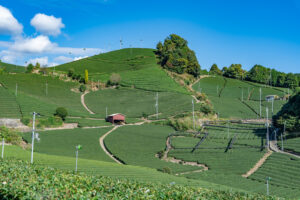
投稿タイプ:sightseeing
Shirasu and Ishitera Tea Plantations
Wazuka Town gradually warms up from west to east in spring. In Ishitera and nearby places, located in the western part of Wazuka, tea picking begins no later than late April. Therefore, the tea plantations in this area are called Hayaba (place of early harvest).
The tea plantations in Shirasu and Ishitera, cultivated with modern methods of agriculture, present beautiful scenery. The tea fields carpet the mountain slopes, forming breathtaking panoramas. In Ishitera, you can enjoy a stunning view of the tea fields that seem to kiss the sky. When you gaze up at the diminutive peak, the surprising vista reveals itself.
These places are a part of tea plantations registered as the first Scenic Assets of Kyoto Prefecture. They are also a part of the Japan Heritage (Japanese Tea: Eight Centuries of Tradition).
As a side note, you can rent an electric bicycle at Wazukacha Cafe and enjoy cycling in Wazuka. Enjoy the town's landscapes and natural scenery. (The tea plantations are private property. Please do not enter them.)
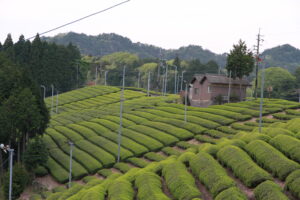
投稿タイプ:sightseeing
Dousenbou Nagano Tea Plantation
Minamiyamashiro Village is Kyoto's only village. Approximately 80% of the village is mountainous, with elevations ranging from 300 to 600 meters. This unique topography led to the development of the slopes for tea cultivation.
Nestled amidst the mountains at an altitude of about 500 meters, Dousenbou is a hamlet in the flatlands that was born in the Meiji Period (1868-1912). The tea plantation owes its prosperity to the bustling tea trade on Kizu River.
Today, you can still appreciate the timeless beauty of the tea fields, combined with rice paddy fields. The tea fields spread along the mountain slopes, which is an impressive sight that will stay with you. This characteristic landscape offers a glimpse into the interplay between the history of modern Uji tea production, and this area's unique environment and cultivation practices.
As a side note, the village has several cycling routes. Enjoy the village's landscapes and natural scenery. (The tea plantations are private property. Please do not enter them.)
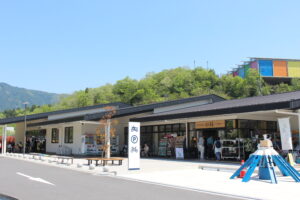
投稿タイプ:sightseeing
Roadside Rest Area Ocha-no-Kyoto Minamiyamashiro Village
This rest area encapsulates the wonderful everyday life of Minamiyamashiro Village. You can immerse yourself in the village life and discover their traditional wisdom through eating, drinking and so on.
They sell a wide variety of local specialties, including tea and fresh vegetables at the market called Nomon Ichiba. Delicious tea sweets would make great gifts for your loved ones.
You can savor genuine tea with ease on the spot, at the sweets and tea shop, Muracha-ya. Their soft serve made with the village’s high-quality matcha green tea is famous for its authentic flavor. The rich matcha syrup poured on it is amazing, too. You can enjoy the beautiful balance of sweetness and pleasurable bitterness. (430 yen, tax included.)
This rest area also has Murafudo Shokudo Tsuchi-no-Ubu, a cozy place where you can relax and enjoy a delicious meal. Savor their dishes incorporating tea. They have delicious ones modeled after the local villagers' meals.
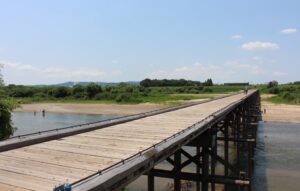
投稿タイプ:sightseeing
Nagarebashi (Kouzuyabashi)
Nagarebashi, officially known as Kouzuyabashi, is a 356.5-meter-long bridge crossing the Kizu River. It is one of the longest wooden bridges in Japan. The name "Nagarebashi" means "a flowing bridge" in English. Sometimes the river experiences a significant water level rise by heavy rain, especially in a typhoon season. Instead of resisting the water flow, the bridge is designed to flow along with it. Of course, it’s not completely washed away. Its walkway naturally gets separated into several parts, and they drift apart from the bridge and float on water, but they’re connected to the bridge piers by wire ropes, actually. To return the washed-away parts to their original positions on the piers, you can pull up the ropes. This is a bridge that adapts to the natural conditions around the river, rather than resisting them.
The wooden bridge has a charming and nostalgic atmosphere. It has been used as a filming location for many historical films and TV shows.
Right beside the bridge, you can see tea plantations. It’s a great place where fertile soil is naturally carried by the river. This area is famous for producing high-quality tea. To ensure the safety of residents, the embankment was strategically constructed to circumvent the tea plantations. It’s a wonderful place to feel the culture of Yawata. The Nagarebashi and the surrounding tea plantations are a part of the Japan Heritage (Japanese Tea: Eight Centuries of Tradition), certified by the Agency for Cultural Affairs.
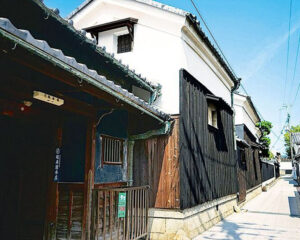
投稿タイプ:sightseeing
Kamikoma Tea Wholesaler District
The Yamashiro area, located in the southern part of Kyoto, is famous for its tea. In and around the Kamikoma area, southern Yamashiro, tea cultivation dates back to the Muromachi Period (1336-1573).
In 1868, Port of Kobe (Hyogo Port) opened, which revolutionized the tea industry. With the exports from the port, tea production skyrocketed. Tea leaves from this and surrounding areas were transported here, and processed by tea merchants. They were then shipped to the port via Kizu River and Yodo River for export overseas.
This area flourished as a tea wholesaler district.
Even today, there remain about 40 tea wholesalers. You can also see a monument of the tea industry of Yamashiro. Take a leisurely stroll and enjoy the quaint atmosphere, feeling the history and tradition.
